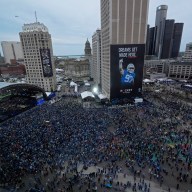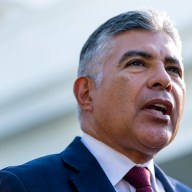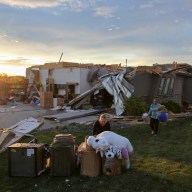KHOSHAB VILLAGE, Afghanistan – Their progress is slow, the sun is hot and the work is dangerous – but that doesn’t seem to matter to the loyal Afghans who are working to restore their country’s former glory.
Community-based demining team No. 2, part of the ongoing efforts by UNMACA, the Afghan division of the United Nations Mine Action Centre, consists of 14 men, including 10 deminers, a team leader, two section leaders and one medic.
Clad in bright blue UN protective vests and full-face visors, the deminers use metal detectors and long, narrow hand-held picks to gingerly prod their way across the countryside, square centimetre by square centimetre, carefully extracting anything made of metal.
It’s perilous work in a country known as the most heavily mined in the world, and one so scarred by decades of war that the landscape is littered with unexploded munitions, not to mention countless scraps of harmless metal detritus.
So far, the team’s efforts near this village in the Daman district, south of Kandahar city, have yielded one anti-tank mine and eight anti-personnel mines. Those who take on this painstaking, back-breaking chore consider it a high calling indeed.
“As you know our country has been mined heavily – we are the people to clear this area and these hazards and save our people’s lives,” team leader Ghulam Bhadim said with pride.
“It has two benefits. One, is it is a holy job, and God will reward us in a future life; second, we have to boost our family and get money so that is why I have selected this holy job.”
The area was once a greenbelt, but the 10-year occupation by Russian invaders during the 1980s and years of ensuing civil war prompted landowners to flee to neighbouring Pakistan. As a result, vast tracts of prime agricultural land sit abandoned and untended, sown with hidden perils.
“It is slow work, but it needs to be done,” said Abdul Ghani, a resident of Khoshab and a five-month veteran of demining efforts in the area.
“When I find a mine, I know I have saved a life, a life from my village. We have known about the mine field here for some time – many villagers have been hurt by them. Now we will take them away.”
Only one injury has been sustained so far; just last week, one of the deminers sustained injuries to his face and hands when a mine he was working on went off.
The ground that has already been cleared is divided into narrow tracts, each dotted with thousands of small holes. Small yellow rocks are used to denote locations where mines were found and removed.
Following this time-consuming procedure, UN mine teams have cleared 270 square kilometres of land in Kandahar province. Throughout Afghanistan, estimates place the number of minefields at more than 1,000, most of them near towns or villages.
And in the southern part of the country, where insurgents continue to sow the ground with improvised explosive devices, the situation has gotten steadily worse over the last eight years, said Alan MacDonald, UNMACA’s chief of staff in Kabul.
“Basically the south now is the most contaminated area of the country,” MacDonald said.
“As long as the insurgency is as problematic as it is in areas like Kandahar, then the rest of the country is going to benefit more from mine clearance than they are.”
MacDonald said the program is now at a difficult phase because the easy part has already been done. Clearing the minefields through to Kabul and Herat, along with those that were associated with historic military posts up and down roads leading to the north, was the easy part, he said.
“We’re now dealing with the issue of where mines have been laid for a number of reasons – a lot have been laid simply for their terror intent. So it’s difficult.”
Canada has been among the leaders in the international battle against landmines in Afghanistan. Ottawa has set aside $9 million for demining efforts in the Kandahar area alone.
“The numbers of square kilometres are not as big as you might think – it’s in the hundreds or maybe low thousands, but it’s not huge, not thousands of square kilometres,”
While a lot of Afghanistan is mined, the area is large, but not overwhelming – something in the low thousands of square kilometres, said Jim Melanson, a Canadian International Development Agency official who’s part of the demining project.
“When you can make an impact of a couple of hundred plus square kilometres, it’s really significant,” Melanson said.
“Look over the years of conflict they’ve had here. There’s got to be stuff going back 20 or 30 years.”
Melanson is particularly proud of the work being done in mine awareness throughout Afghanistan. He said 120,000 locals have been trained to be more mine-aware in Kandahar province since the program began in 1988.
At a mine awareness class about five kilometres away, teacher Bakhat Mohammad from Handicap International was giving the basics to a giggling class of about 30 small boys and three girls. Using charts and brochures, he offered advice on what mines look like and what areas to avoid.
“Most of them were very interested and they could learn. When I asked them about the class they had gotten everything,” Mohammed said afterward.
“Some of the children are shy – they are not answering, but they are learning.”
















